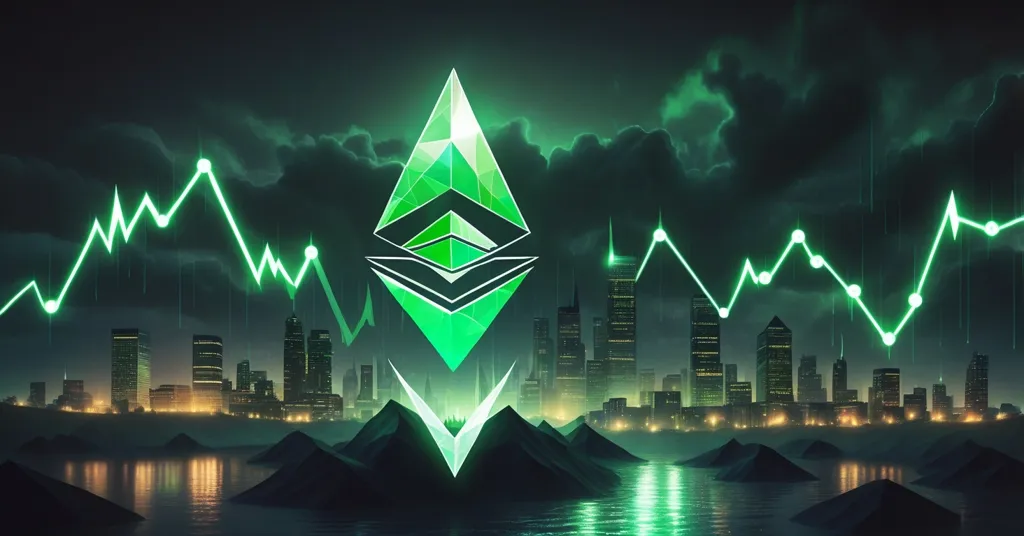Ethereum’s Morning Star: Bullish Signal Sparks Hope for ETH Rally

Ethereum’s Bullish Morning Star: Is an ETH Rally Finally Here?
Ethereum (ETH), the powerhouse behind smart contracts and decentralized finance, is flashing signs of a potential breakout with a technical pattern that’s got the crypto community buzzing. Despite trading 33% below its June 2024 highs, could this be the moment ETH shakes off its slump and surges forward?
- Technical Trigger: A Morning Star candlestick pattern on ETH’s monthly chart signals a bullish reversal.
- Institutional Surge: Massive inflows into Ethereum ETFs and ETPs reflect growing confidence from big money players.
- On-Chain Momentum: Rising staking and exchange outflows hint at a supply crunch, bolstering price potential.
Technical Signals: A Morning Star Lights the Path
Let’s get straight to the point—Ethereum’s price action is showing flickers of hope after a rough patch. Trading at $2,538 as of now (up a modest 0.8% in the last 24 hours), ETH has managed a 37.7% gain over the past month, yet it’s still a far cry from its peak earlier this year. What’s caught the eye of traders, though, is a formation known as the Morning Star candlestick pattern on its monthly chart, flagged by crypto trader Merlijn The Trader. For the uninitiated, this is a three-candle setup often seen at the bottom of a downtrend: a large bearish candle showing sellers in control, a small indecisive one signaling hesitation, and a strong bullish candle indicating buyers stepping back in with force. Historically, it’s a decent predictor of a trend shift, though not foolproof. Has it worked for Ethereum before? Data on past patterns is mixed—sometimes it’s heralded rallies, other times it’s fizzled out. Still, it’s a spark worth watching.
Beyond this, ETH is holding above its 200-day exponential moving average (EMA)—a key line on the chart that, when price stays above it, often suggests continued upward potential. Analyst Titan of Crypto also points to a bullish flag pattern on the daily chart, a shape that typically hints at a price surge after a brief consolidation. If momentum builds, they’re eyeing a target of $3,800. Meanwhile, Ali Martinez pegs $2,550 as a critical support level; hold that, and a push to $2,650 could be next. These technicals paint a hopeful picture, but charts don’t tell the whole story in a market as wild as crypto.
Institutional Money: Big Bets on Ethereum’s Future
While traders geek out over candlesticks, the suits in traditional finance are making moves that could give ETH a real boost. A recent CoinShares report revealed a whopping $286 million in net inflows into global crypto exchange-traded products (ETPs) for the week ending May 30, with Ethereum-based products grabbing a hefty share. Even more impressive, spot Ethereum ETFs saw $564 million in net inflows in May 2024—let’s assume that’s the correct year, as 2025 seems a typo—compared to just $66 million the prior month, according to SoSoValue data. That’s not just a vote of confidence; it’s a roaring endorsement from institutional investors who see Ethereum as a pillar of the future financial landscape.
But let’s not get too starry-eyed. Institutional inflows are a double-edged sword. Sure, they bring stability and demand, but if market sentiment flips—as it has in past crypto winters—these same players could pull out faster than you can say “bear market.” Remember 2022, when risk assets tanked across the board? Crypto wasn’t spared, no matter how much big money had poured in. For now, though, the tide looks bullish, and that kind of cash can’t be ignored, as seen in ongoing discussions about ETF inflows.
On-Chain Dynamics: Staking and Supply Crunch Fuel Optimism
Digging into the blockchain data, Ethereum’s fundamentals are showing strength. Since its shift to proof-of-stake (PoS) with the 2022 Merge, staking has become a core mechanic—users lock up ETH to validate transactions and secure the network, earning rewards in return. Recently, Abraxas Capital staked $7.5 million worth of ETH, as noted by analyst Ted Pillows on social media platform X. They’re not alone; over 30 million ETH is already staked network-wide, effectively yanking that supply off the market. This acts as a deflationary force, especially paired with Ethereum’s fee-burning mechanism (EIP-1559), which destroys a portion of transaction fees. Less ETH to go around can mean higher prices if demand holds, as explored in staking impact analyses.
Then there’s the exchange activity—or lack thereof. Nearly 300,000 ETH left Binance between mid-April and mid-May, per on-chain data, while Reddit chatter in r/EthTrader cites whale accumulation of over 330,000 ETH (worth $1 billion) in a single week. These so-called whales—large investors with deep pockets—buying up huge chunks while supply dwindles on exchanges like Binance suggests reduced selling pressure. It’s a classic setup for a supply crunch scenario, where scarcity could drive prices up if buyers keep piling in. But a word of caution: staking locks up liquidity, and if stakers suddenly unstake en masse—say, if rewards disappoint or they need cash—supply could flood back. Plus, over-staking risks centralization if too few validators dominate, potentially making the network less secure. It’s a bullish signal, but not without wrinkles.
Risks on the Horizon: Not All Sunshine for ETH
Before we start engraving Ethereum’s name on the moon, let’s ground ourselves with some harsh realities. Yes, the Morning Star and inflows are exciting, but ETH isn’t without its baggage. Scalability remains a thorn in its side—despite layer-2 solutions like Arbitrum and Optimism (which process transactions off the main chain to ease congestion), gas fees, or transaction costs, still spike during high-demand periods like NFT mints. Just last year, average fees hit $50+ during peak times, per Etherscan data, pricing out smaller users. Competitors like Solana and Avalanche offer faster, cheaper transactions, and they’re hungry to steal developers and dApps from Ethereum’s ecosystem. Could they chip away at ETH’s dominance?
Then there’s the macro environment. If central banks keep tightening interest rates or global markets sour, risk assets like crypto get hammered—hard. Ethereum isn’t immune, no matter how pretty its charts look, as pointed out in recent technical breakout analyses. Regulatory uncertainty adds another layer of dread. Even with ETF approvals, the U.S. SEC or global bodies like the EU could slap down policies targeting DeFi or staking yields at any moment. Look at recent murmurs of stricter crypto laws in Asia—those could spook institutional players faster than a meme coin rug pull. And speaking of scams, while Ethereum itself isn’t the culprit, its ecosystem is riddled with shady projects; any major blowup could tarnish sentiment by association.
What This Means for Ethereum’s Future
Ethereum stands at a crossroads. The technical signals, institutional backing, and on-chain data scream potential breakout, with some community outliers even tossing around pie-in-the-sky targets like $7,000 based on whale buying trends, as noted in NewsBTC reports. I’m not here to peddle that kind of hopium—those numbers are more fantasy than forecast—but it shows the wild optimism floating around, including insights from bullish pattern reports. As a champion of decentralization, I’m rooting for ETH to disrupt the financial status quo, just as I see Bitcoin as the ultimate store of value. Ethereum’s utility in DeFi, NFTs, and beyond fills a niche BTC doesn’t touch, and that’s vital for this revolution. Yet, I’m not blind to the pitfalls. This rally could kick off with a bang, or it could flop like a bad altcoin. The next few weeks will reveal whether fundamentals outweigh the risks or if we’re in for another false dawn.
Key Takeaways and Questions on Ethereum’s Potential Rally
- What does the Morning Star candlestick pattern signify for Ethereum?
It’s a bullish reversal signal after a downtrend, formed by three candles that suggest buyers are taking control, potentially setting ETH up for a rally as highlighted by trader Merlijn The Trader. - How is institutional interest shaping Ethereum’s outlook?
With $286 million in recent ETP inflows and $564 million into spot Ethereum ETFs, traditional finance is betting big on ETH, likely providing price support or upward pressure. - Why are staking and exchange outflows important for ETH’s price?
Staking locks up supply (like Abraxas Capital’s $7.5 million move), while outflows of nearly 300,000 ETH from Binance reduce selling pressure—both can fuel price gains if demand persists. - What price levels are critical for Ethereum’s bullish momentum?
Support at $2,550 is key, per analyst Ali Martinez, with a near-term target of $2,650 if it holds; Titan of Crypto sees $3,800 as feasible on a bullish breakout, though speculative highs like $7,000 are floated by some. - What risks could derail Ethereum’s potential rally?
Scalability woes, high gas fees, competition from blockchains like Solana, macroeconomic headwinds, and regulatory crackdowns could all stall ETH’s momentum, despite strong technicals.
Ethereum’s journey embodies the raw potential of decentralized systems to challenge outdated financial structures. As we push for adoption and accelerate innovation, we must stay sharp to the hazards. This isn’t about blind hype or shilling nonsense predictions—it’s about spotting opportunity while keeping both feet on the ground. Whether ETH soars or stumbles, the story unfolding now is one to watch closely.



